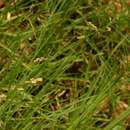Comments
provided by eFloras
Known in South Africa as Hartjesgras, it is said to be a moderately good species for pasture and for making into hay.
- license
- cc-by-nc-sa-3.0
- copyright
- Missouri Botanical Garden, 4344 Shaw Boulevard, St. Louis, MO, 63110 USA
Description
provided by eFloras
Caespitose perennial; culms 20-120 cm high, erect. Leaf-blades flat, up to 40 cm long and 10 mm wide, firm, glaucous. Panicle lanceolate to broadly ovate, 10-30 cm long; primary branches stout, usually with secondary branchlets but sometimes almost raceme-like, the spikelets on short pedicles 1-5 mm long. Spikelets 6-28 (-47)-flowered, narrowly ovate to suborbicular, 6-16(23) mm long, 3-10 mm wide, strongly flattened, green tinged with brownish purple, disarticulating below the glumes at maturity and falling entire; glumes lanceolate in side-view, subequal, 24 mm long; lemma narrowly ovate in side-view, 3-4.5 mm long, strongly keeled, the keel scaberulous, narrowly obtuse; palea 2-nerved, the nerves thickened, cartilaginous and bearing a hyaline minutely ciliolate wing; anthers 3, 2 mm long. Caryopsis ellipsoid, 1-1.5 mm long.
- license
- cc-by-nc-sa-3.0
- copyright
- Missouri Botanical Garden, 4344 Shaw Boulevard, St. Louis, MO, 63110 USA
Distribution
provided by eFloras
Distribution: Pakistan (Sind, introduced); a native of tropical and South Africa; an exotic introduction in India and Pakistan.
- license
- cc-by-nc-sa-3.0
- copyright
- Missouri Botanical Garden, 4344 Shaw Boulevard, St. Louis, MO, 63110 USA
Derivation of specific name
provided by Flora of Zimbabwe
superba: superb, proud
- license
- cc-by-nc
- copyright
- Mark Hyde, Bart Wursten and Petra Ballings
- bibliographic citation
- Hyde, M.A., Wursten, B.T. and Ballings, P. (2002-2014). Eragrostis superba Peyr. Flora of Zimbabwe website. Accessed 28 August 2014 at http://www.zimbabweflora.co.zw/speciesdata/species.php?species_id=105220
- author
- Mark Hyde
- author
- Bart Wursten
- author
- Petra Ballings
Description
provided by Flora of Zimbabwe
Perennial tufted grass, up to 1,2 m. Inflorescence a panicle. Spikelets straw-coloured to pinkish, large, oval and conspicuously flattened with typically serrated edges.
- license
- cc-by-nc
- copyright
- Mark Hyde, Bart Wursten and Petra Ballings
- bibliographic citation
- Hyde, M.A., Wursten, B.T. and Ballings, P. (2002-2014). Eragrostis superba Peyr. Flora of Zimbabwe website. Accessed 28 August 2014 at http://www.zimbabweflora.co.zw/speciesdata/species.php?species_id=105220
- author
- Mark Hyde
- author
- Bart Wursten
- author
- Petra Ballings
Worldwide distribution
provided by Flora of Zimbabwe
Sudan southwards to S Africa
- license
- cc-by-nc
- copyright
- Mark Hyde, Bart Wursten and Petra Ballings
- bibliographic citation
- Hyde, M.A., Wursten, B.T. and Ballings, P. (2002-2014). Eragrostis superba Peyr. Flora of Zimbabwe website. Accessed 28 August 2014 at http://www.zimbabweflora.co.zw/speciesdata/species.php?species_id=105220
- author
- Mark Hyde
- author
- Bart Wursten
- author
- Petra Ballings
Physical Description
provided by USDA PLANTS text
Perennials, Terrestrial, not aquatic, Stems nodes swollen or brittle, Stems erect or ascending, Stems caespitose, tufted, or clustered, S tems terete, round in cross section, or polygonal, Stem internodes solid or spongy, Stem internodes hollow, Stems with inflorescence less than 1 m tall, Stems with inflorescence 1-2 m tall, Stems, culms, or scapes exceeding basal leaves, Leaves mostly basal, below middle of stem, Leaves mostly cauline, Leaves sheathing at base, Leaf sheath mostly open, or loose, Leaf sheath smooth, glabrous, Leaf sheath hairy at summit, throat, or collar, Leaf sheath and blade differentiated, Leaf blades linear, Leaf blades 2-10 mm wide, Leaf blades mostly flat, Leaf blade margins folded, involute, or conduplicate, Leaf blades mostly glabrous, Leaf blades scabrous, roughened, or wrinkled, Ligule present, Ligule a fringe of hairs, Inflorescence terminal, Inflorescence an open panicle, openly paniculate, branches spreading, Inflorescence solitary, with 1 spike, fascicle, glomerule, head, or cluster per stem or culm, Inflorescence branches more than 10 to numerous, Flowers bisexual, Spikelets pedicellate, Spikelets laterally compressed, Spikelet less than 3 mm wide, Spikelets with 3-7 florets, Spikelets with 8-40 florets, Spikelets solitary at rachis nodes, Spikelets all alike and fertille, Spikelets bisexual, Spikelets disarticulating above the glumes, glumes persistent, Spikelets disarticulating beneath or between the florets, Rachilla or pedicel glabrous, Glumes present, empty bracts, Glumes 2 clearly present, Glumes equal or subequal, Glumes shorter than adjacent lemma, Glumes 1 nerved, Lemmas thin, chartaceous, hyaline, cartilaginous, or membranous, Lemma similar in texture to glumes, Lemma 3 nerved, Lemma glabrous, Lemma apex truncate, rounded, or obtuse, Lemma awnless, Lemma margins thin, lying flat, Lemma straight, Palea present, well developed, Palea membranous, hyaline, Palea shorter than lemma, Palea 2 nerved or 2 keeled, Palea keels winged, scabrous, or ciliate, Stamens 3, Styles 2-fid, deeply 2-branched, Stigmas 2, Fruit - caryopsis, Caryopsis ellips oid, longitudinally grooved, hilum long-linear.
Eragrostis superba: Brief Summary
provided by wikipedia EN
Eragrostis superba is a species of perennial tufted grass in the family Poaceae. It is a palatable forage species but occurs at low densities.
It occurs from Sudan to South Africa, and flowers during the rainy season. The large, flat and oval-shaped spikelets are carried in long panicles. They have serrated edges and a purple or pinkish hue when fresh. It is native to sandy soils in open woodlands or sparse grassland, up to about 1,500 m in altitude, or occurs as a pioneer in disturbed areas.
- license
- cc-by-sa-3.0
- copyright
- Wikipedia authors and editors


![]() Media related to Eragrostis superba at Wikimedia Commons
Media related to Eragrostis superba at Wikimedia Commons